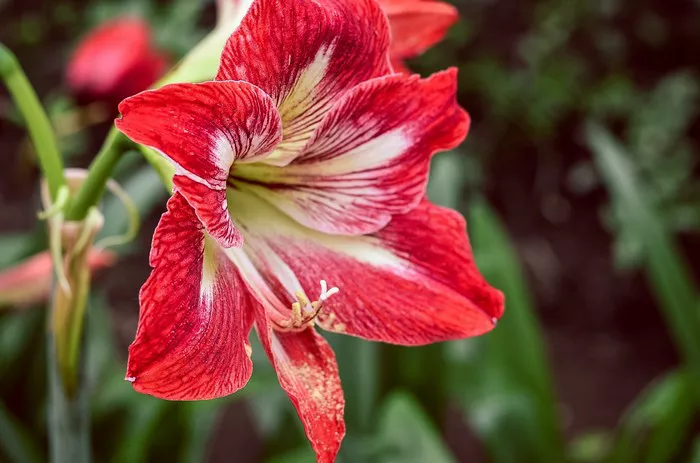Amaryllis, with its majestic blooms and vibrant colors, has secured its place as a beloved flower in homes and gardens around the world. Whether adorning indoor spaces during the winter months or gracing outdoor gardens in warmer climates, the allure of the Amaryllis is undeniable. However, for those eager to witness the spectacular display of its blossoms, a common question arises: How long does it take for an Amaryllis to flower? Delving into the intricacies of its growth cycle provides valuable insights for enthusiasts and gardeners alike.
Understanding the Amaryllis Growth Cycle
Before delving into the timeline of Amaryllis flowering, it’s crucial to understand the stages it undergoes in its growth cycle. Amaryllis originates from South America and consists of large bulbs that produce tall, sturdy stalks topped with magnificent trumpet-shaped flowers. Typically, the growth cycle of an Amaryllis can be divided into four key stages:
1. Bulb Dormancy: During this phase, the Amaryllis bulb remains dormant, often triggered by environmental factors such as temperature and light. This period allows the bulb to conserve energy and prepare for the subsequent growth stages.
2. Emergence of Foliage: As the bulb emerges from its dormant state, it begins to produce foliage characterized by long, strap-like leaves. This stage is crucial for photosynthesis, as the leaves absorb sunlight and convert it into energy to fuel the plant’s growth.
3. Bud Formation: Following the emergence of foliage, the Amaryllis enters the bud formation stage. This is when the plant allocates resources towards developing flower buds, which gradually grow and mature within protective bracts.
4. Flowering: The pinnacle of the Amaryllis growth cycle is the flowering stage, where the buds unfurl into stunning blooms. Depending on the variety, Amaryllis flowers can range in color from deep reds and pinks to pristine whites and soft pastels, captivating observers with their beauty and fragrance.
Factors Influencing Flowering Time
Several factors influence the time it takes for an Amaryllis to flower, making it a dynamic process that varies from one plant to another. Some of the key factors to consider include:
1. Bulb Size and Health: Healthy, robust bulbs tend to flower more quickly than weaker ones. Larger bulbs often have more energy reserves, enabling them to initiate flowering sooner.
2. Environmental Conditions: Light, temperature, and humidity play crucial roles in regulating the growth and flowering of Amaryllis plants. Adequate sunlight and moderate temperatures are ideal for promoting healthy growth and timely flowering.
3. Cultivation Method: Whether grown indoors or outdoors, the cultivation method can impact flowering time. Indoor-grown Amaryllis may flower earlier due to controlled environmental conditions, whereas outdoor-grown specimens may experience delays influenced by seasonal changes.
4. Variety: Different Amaryllis varieties exhibit varying growth habits and flowering times. Some cultivars are known for their early flowering, while others may take longer to reach maturity.
Timeframe for Amaryllis Flowering
While the exact timeframe for Amaryllis flowering can vary depending on the factors mentioned above, a general estimate can be provided based on typical growth patterns. On average, it takes approximately 6 to 8 weeks from the emergence of foliage for an Amaryllis to flower. However, this timeframe is subject to variation and may be influenced by individual plant characteristics and environmental conditions.
Tips for Encouraging Timely Flowering
To maximize the chances of timely flowering and ensure a spectacular display of blooms, consider the following tips:
1. Provide Adequate Sunlight: Place your Amaryllis in a location where it receives plenty of bright, indirect sunlight. This is essential for promoting healthy growth and bud development.
2. Maintain Optimal Temperature: Amaryllis plants prefer moderate temperatures ranging from 65 to 75 degrees Fahrenheit (18 to 24 degrees Celsius). Avoid exposing them to extreme heat or cold, as this can hinder flowering.
3. Water Wisely: Keep the soil evenly moist but not waterlogged during the growing season. Overwatering can lead to bulb rot, while underwatering may stunt growth and delay flowering.
4. Fertilize Sparingly: Use a balanced fertilizer formulated for flowering plants to provide essential nutrients during the growing season. Apply fertilizer according to the manufacturer’s instructions, avoiding excessive use that can damage the plant.
5. Support Growing Stalks: As the Amaryllis stalks grow taller, provide support with stakes or trellises to prevent bending or toppling. This ensures that the flowers remain upright and showcase their beauty to the fullest.
By following these guidelines and understanding the nuances of the Amaryllis growth cycle, enthusiasts can anticipate the timely emergence of exquisite blooms, transforming their homes and gardens into vibrant showcases of natural beauty.
Conclusion
The journey from bulb to blossom is a captivating spectacle in the world of gardening, with the Amaryllis standing out as a star performer. While the exact time it takes for an Amaryllis to flower may vary, a combination of favorable growing conditions and proper care can expedite the process, allowing enthusiasts to enjoy the splendor of its blooms without undue delay. With patience, diligence, and a touch of botanical know-how, the beauty of the Amaryllis can be unlocked, enriching indoor spaces and outdoor landscapes with its timeless charm.


